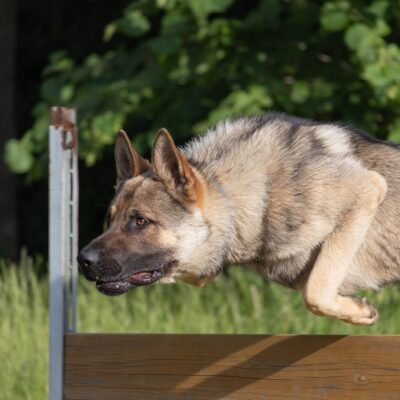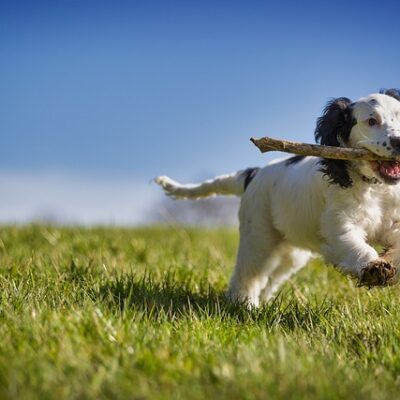Why Do Dogs Chase Their Tails? Most of the time it’s caused by boredom. However, other causes may be due to skin infections, attention-seeking, genetics, or behavioral issues. This article will provide you with information about these issues, as well as some hints and tips on reducing the frequency of tail chasing.
Busy? Get Your Hands Paws On The Answers Quickly…
- Why Do Dogs Have Tails?
- Do Dogs Know They Have Tails?
- Why Do Dogs Chase Their Tails?
- How Do You Stop A Dog From Chasing Its Tail?
- FAQs
So, as a dog owner, you may have asked yourself, – why do dogs have tails? Firstly, let us rule out the answer of ‘to chase it.’ Dogs have tails to help them balance, move, and communicate with their owners and other dogs. If you’re looking for more info on this question, check out our blog post ‘why do dogs have tails’?
Yes, of course. It is a dog’s primary way of communicating and expressing their feelings towards humans and other dogs. However, at their puppy stage, they will not know it’s apart of their body and may think it’s a sort of toy. This is one of many explanations for chasing their tails, especially when they’re a puppy.
WHY DO DOGS CHASE THEIR TAILS?
Boredom
Boredom is the most common and explainable reason for a dog chasing their tail. If your dog is young and still in their puppy stage, they are likely to chase their tail regularly. A puppy is expected to chase their tail as they need stimulating and have excess energy levels. You need to stimulate your dog in different ways; toys, treat games, training, and fun play to help prevent or reduce the tail chasing.
Attention Seeking
You may notice that your dog stops chasing their tail once they have received some communication from their owner. Dogs are very sociable pets and love to gain attention and affection from their owners. If they realize they can receive this by chasing their tail, they may use this behavior as a way of begging for affection.
Behavioral Issues
Although it’s very rare, some neurological conditions cause a dog to chase their tail. Research suggests that these behavioural conditions can be repeated to epilepsy or minute seizure-related conditions.
Fleas
Fleas are biting insects that bury themselves deep into an animal’s fur. Therefore, dogs with big bushy tails are more likely to attract fleas. If you notice your dog doesn’t chase its tail but suddenly does the next, it’s a good idea to take ti to the vets and discuss flea prevention medication.
Genetics, Breed & Age
Some breeds of dogs are more prone to chasing their tails. Terriers and Shepard dogs are more likely to chase their tail than any other dog. Consistent training will help to reduce the frequency of tail having but may never stop it completely.
In regards to a dog age, a puppy is more likely to chase their tail. As a dog gets older, they will tend to stop the tail chasing. This is due to them having lower levels of energy.
HOW DO YOU STOP A DOG FROM CHASING ITS TAIL?
- Ignoring this behavior is the best. Do not give them any attention (positive or negative) as they begin to learn that this behavior provides them with the attention they seek.
- Your dog may have too much energy, and therefore their activity levels should be increased. Playing in the garden or an extra short walk will help t exert their energy.
- Provide your dog with stimulating toys. These can be shop-purchased or homemade. Our blog posts on ‘Can dogs eat’ provides alternate ways of treating a dog.
- Make extra time to monitor your dog’s tail-chasing behavior as well as checking their hair for any fleas or skin irritations.
Why does my dog chase his tail in circles?
For the same reason as this article explain. It is most likely caused by your dog exerting energy.
Is it normal for a dog to chase his tail?
As a puppy, yes. However, this behavior in an adult dog is unusual, and I recommended the owner seeks advice from their veterinarian.
Do dogs get dizzy from chasing their tails?
Possibly. If a dog is whirling round and round at high speeds chasing their tails, they will tend to stop once they’ve become dizzy, fatigued, or caught their prey (tail).
Can you legally dock dogs tails?
Only specific working dog breeds are allowed to have their tails docked by a fully qualified veterinarian. The owner of a docked dog will receive a certificate, and this should be passed on to any new owners. A dog should not have their tail docked after the age of 5 days.
Can you dock a dog’s tail at 6 months old?
IIn short, yes. However, most vets will only carry out this traumatic procedure if the tail has been injured. Dogs should have their tails docked at a young age (before 5 days old).
Looking for more pawsome posts? Check these out…
Can Dogs Eat Lettuce?
How To Make A Snuffle Mat
When Do Puppies Lose Their Teeth?
Can Dogs Eat Broccoli?
Can Dogs Eat Watermelon?
Disclaimer: Each dog is different, and every circumstance is different. All efforts have been made to provide accurate information. However, it is not provided by a qualified Veterinarian, Veterinarian Surgeon, or Behaviorist. The information provided is purely educational. The information should not be used as an alternative or substitute for medical care. If you have any health or medical concerns, contact a qualified Veterinary Surgeon or Veterinarian immediately.










No Comment! Be the first one.